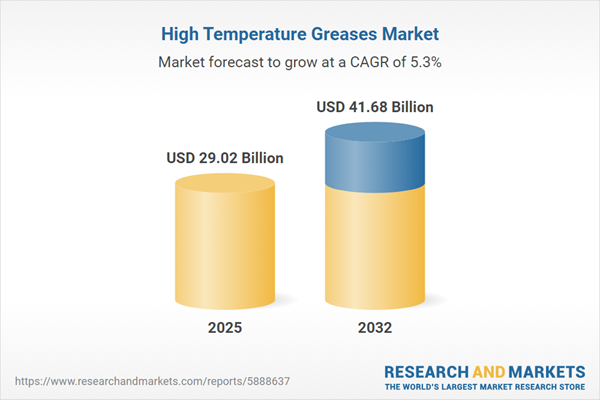Speak directly to the analyst to clarify any post sales queries you may have.
As industries modernize, senior executives are prioritizing solutions that strengthen operational reliability and compliance. The global high temperature greases market is a strategic asset for ensuring machinery durability, process stability, and proactive adaptation as manufacturing standards shift.
Market Snapshot: Global High Temperature Greases Market
The global high temperature greases market is valued at USD 27.57 billion in 2024 and is projected to reach USD 29.02 billion by 2025, with a compound annual growth rate of 5.30%. Forward-looking investment trends indicate continued expansion, with the market expected to reach USD 41.68 billion by 2032. These dynamics highlight a consistent demand for advanced lubrication across heavy industry, as leaders focus on asset protection, process reliability, and reducing costly downtime. Ongoing advancements in specialty lubricants are enabling both lower equipment failure rates under high-heat conditions and more straightforward compliance with ever-changing regulations.
Scope & Segmentation of the Global High Temperature Greases Market
- End Use Industries: Addresses critical operational needs in aerospace, automotive, energy, food processing, heavy manufacturing, mining, cement, steel, aluminum, and pulp production, with each sector depending heavily on uninterrupted machine uptime.
- Applications: Designed for high-stress components such as bearings, gears, chains, and couplings, especially those performing under elevated temperatures and rigorous load cycles.
- Type: Incorporates aluminum complex, calcium sulfonate, lithium complex, and polyurea greases, each supporting specific maintenance and performance strategies in demanding environments.
- Base Oil Type: Offers mineral, semi-synthetic, and synthetic formulations, including ester and PAO, giving operational leaders diverse options aligned with sustainability objectives and efficiency goals.
- Product Form: Available in NLGI grades 0, 1, and 2, allowing equipment managers to match viscosity to precise asset requirements across a spectrum of temperature and pressure conditions.
- Temperature Range: Ensures sustained protection for assets exposed to environments exceeding 150°C, where lubrication performance is vital for extended reliability.
- Sales Channels: Distributed through direct supplier partnerships, industrial distribution, and digital procurement platforms, supporting resilient and flexible sourcing strategies across all regions.
- Geography: Reflects diverse regulatory, industrial, and operational demands in the Americas, Europe, Middle East and Africa, and Asia-Pacific. Markets such as the United States, China, Germany, India, and Brazil continue to shape usage patterns and technological adoption.
- Key Players: Led by Exxon Mobil Corporation, Shell plc, Chevron Corporation, Fuchs Petrolub SE, BP p.l.c., TotalEnergies SE, The Lubrizol Corporation, Klüber Lubrication München KG, Dow Inc., and AB SKF, driving innovation and scalability across global supply chains.
Key Takeaways for Senior Decision-Makers
- Modern advancements in thickeners and lubricant additives directly enhance operational reliability, supporting seamless machine operation in high-heat, demanding settings.
- Adoption of synthetic and advanced base oils extends maintenance intervals and aligns with sector-specific compliance, improving resource allocation and predictability for critical equipment.
- Condition monitoring technology plays a pivotal role in targeting lubrication needs, supporting reduced maintenance frequency and more efficient capital deployment.
- Diversified distribution models—balancing physical and digital channels—deepen supply chain agility and responsiveness to local procurement needs.
- Custom lubricant solutions help mitigate contamination risk, particularly relevant to sectors with stringent safety and purity requirements, such as food processing and energy.
- Sustainable procurement approaches are shaping buying decisions as industries increasingly align lubrication strategies with broader environmental and regulatory commitments.
Tariff Impact: United States 2025 Tariffs
New U.S. tariffs on high temperature greases and related components are prompting a strategic review of sourcing models. Manufacturers are expanding supplier networks, embracing regional procurement, and evaluating backward integration to maintain reliable access to key materials and minimize risks from shifting trade policies.
Methodology & Data Sources
This analysis relies on interviews with senior executives and technical specialists, comprehensive reviews of industry-leading databases, and up-to-date regulatory assessments. Findings have undergone peer review to ensure credibility, accuracy, and relevance for executive decision-making.
Why This Report Matters
- Offers senior executives timely insights on advanced lubrication technologies and compliance strategies across manufacturing and heavy industry segments.
- Delivers actionable perspectives for procurement and operations teams seeking to optimize supplier reliability, address regulatory complexity, and adapt to evolving market needs.
- Supports asset protection and production continuity initiatives, enabling better anticipation of future operational pressures and compliance challenges.
Conclusion
Monitoring global high temperature greases market trends equips decision-makers to reinforce operational strength, proactively address regulatory shifts, and ensure ongoing, compliant asset performance across industrial environments.
Additional Product Information:
- Purchase of this report includes 1 year online access with quarterly updates.
- This report can be updated on request. Please contact our Customer Experience team using the Ask a Question widget on our website.
Table of Contents
3. Executive Summary
4. Market Overview
7. Cumulative Impact of Artificial Intelligence 2025
Companies Mentioned
The companies profiled in this High Temperature Greases market report include:- Exxon Mobil Corporation
- Shell PLC
- Chevron Corporation
- Fuchs Petrolub SE
- BP p.l.c.
- TotalEnergies SE
- The Lubrizol Corporation
- Klüber Lubrication München KG
- Dow Inc.
- AB SKF
Table Information
| Report Attribute | Details |
|---|---|
| No. of Pages | 188 |
| Published | November 2025 |
| Forecast Period | 2025 - 2032 |
| Estimated Market Value ( USD | $ 29.02 Billion |
| Forecasted Market Value ( USD | $ 41.68 Billion |
| Compound Annual Growth Rate | 5.3% |
| Regions Covered | Global |
| No. of Companies Mentioned | 11 |









